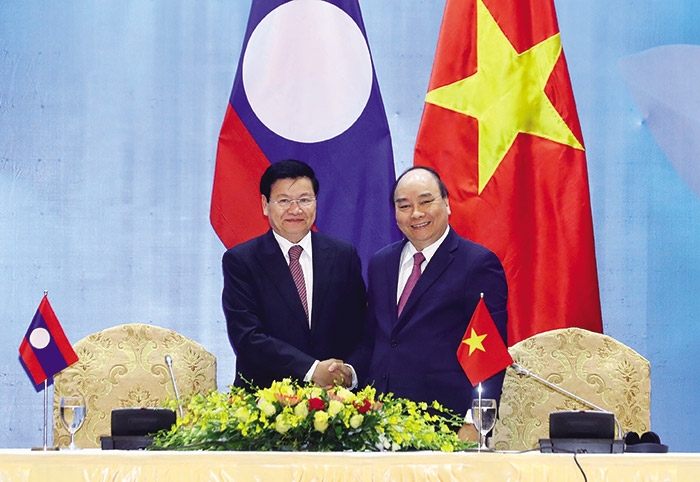Joint projects a priority for Vietnam and Laos
 |
| Prime Minister Nguyen Xuan Phuc (right) and his Lao counterpart Thongloun Sisoulith Photo: VNA |
At the 41th session of the Vietnam-Laos Inter-governmental Committee in Hanoi on January 6, co-chaired by Vietnamese and Laos prime ministers Nguyen Xuan Phuc and Thongloun Sisoulith, both leaders stated that their governments will boost the implementation of Vietnamese projects in Laos and vice versa, especially those in hydropower, air and seaports, electricity, and infrastructure.
Another focus will also be placed on speeding up the implementation of delayed Vietnamese projects in the neighbouring country.
According to a bilateral co-operation plan for 2019 signed between the two governments, “The two nations will further facilitate Vietnamese investors into Laos and Laotian investors into Vietnam to seek investment opportunities and deploy their projects. Priorities will be given to enterprises of both nations in implementing projects in areas along the borderline.”
| " In the co-operation plan, the Vietnamese side committed to continue facilitating Laos to export and import goods via all seaports across the country. " |
“The Lao government will continue creating incentives and favourable conditions to Vietnam’s key projects in remote and difficult areas of Laos, and will also consider and review all regulations and mechanisms about time frames for Vietnamese investments into the hydropower and mining sectors.”
Both nations also agreed to further co-operate with the Japan International Cooperation Agency to mobilise the Japanese government to support the feasibility study and finance the project of the Hanoi-Vientiane expressway, with a focus to be laid on constructing the Vientiane-Paksan-Thanh Thuy section which meets the central Vietnamese province of Nghe An.
The two governments also agreed to complete negotiations and sign a deal on constructing a railway connecting Vientiane and Nghe An’s Vung Ang Seaport. They will also boost the implementation of an agreement on developing three wharfs at the seaport.
A few years ago, the two countries inked an agreement on using this port, with the establishment in 2011 of the Lao-Viet International Port JSC in charge of using the port’s three wharfs to transport goods to Laos. Wharfs one and two became operational in 2001 and 2010 respectively. Meanwhile the third is under construction and expected to be put in operation this year. A further three will be constructed in the near future by both local and foreign businesses.
The Vietnamese side committed that it will continue facilitating Laos to export and import goods via all seaports of Vietnam. Total two-way trade hit over $1 billion in 2018, up 14 per cent on-year.
According to statistics from the Vietnamese Ministry of Planning and Investment, at present, Laos has licensed 409 Vietnamese projects, with the total registered capital of $4.1 billion, making Vietnam the third-largest foreign investor in the neighbouring nation, after China and Thailand.
However, Vietnam’s investment into Laos seems to be slowing down, with the total disbursed sum being about only $1.9 billion so far. A number of investment projects, especially key ones in the sectors of hydropower, mining, and rubber plantation, are bogged down in difficulties.
Both governments have also agreed to combine closely to remove these obstacles and boost the implementation of Nongkhang Airport in Houaphan province. Construction of the $80 million project, invested by Vietnam’s Hoang Anh Gia Lai Group, began in 2013 and was expected to last two years. However, complexities have slowed down the project.
Nevertheless, many major Vietnamese projects have come into good operation in Laos, such as the Xekaman 1 hydropower plant, Muong Thanh Vientiane Hotel, Viettel’s telecommunications plan, Ha Do’s Nong Tha urban area, ventures by Lao-Vietnam Bank, Vietcombank, VietinBank, Sacombank, and a number of projects by Vietnam Rubber Industry Group and Hoang Anh Gia Lai.
In 2018, Vietnam licensed eight projects to be invested in Laos, with the total registered capital of $95 million, up 2.6 times against 2017.
In October 2018 the planning and investment ministries of both nations reviewed all Vietnamese investment projects in Laos, and they have also reported to the two prime ministers, asking them to direct relevant ministries and agencies to solve difficulties facing investors. The Vietnamese side has also sent documents to investors, requiring them to obey all regulations and laws of Laos, and implement all their commitments with the Lao government.
Vietnam’s investments in Laos are focused largely in the hydropower sector, with the total capital of $1.47 billion or 29.4 per cent of Vietnam’s total investments in Laos, followed by the service and infrastructure sector at over $1 billion (20 per cent), mining at $970 million (19.4 per cent), agri-forestry at $903.5 million (18 per cent), as well as other sectors such as property, and finance and banking.
What the stars mean:
★ Poor ★ ★ Promising ★★★ Good ★★★★ Very good ★★★★★ Exceptional
Related Contents
Latest News
More News
- EVN launches major power infrastructure projects nationwide (December 19, 2025 | 18:17)
- VAL inaugurates second production line to meet domestic animal feed demand (December 19, 2025 | 16:37)
- Sun Group pioneers urban tram system in Phu Quoc (December 19, 2025 | 15:00)
- Seven major projects launched to drive Hanoi’s next growth phase (December 19, 2025 | 14:00)
- Securing capital and efficiency for Vietnam’s 2026-2030 growth ambitions (December 17, 2025 | 10:00)
- Vietnam bucking trend in the global M&A landscape (December 16, 2025 | 14:20)
- HDS Summit spotlights Vietnam’s rising role in regional supply chains (December 16, 2025 | 08:00)
- Kolon signs $48 million airbag supply deal with Autoliv (December 15, 2025 | 18:14)
- National Assembly approves Vinh–Thanh Thuy expressway project (December 15, 2025 | 18:02)
- Quang Tri green-lights $1.59 billion LNG-fired power project (December 15, 2025 | 17:59)

 Tag:
Tag:






















 Mobile Version
Mobile Version